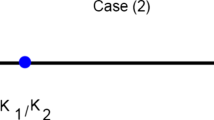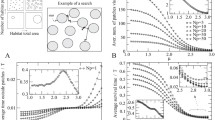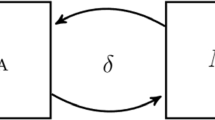Abstract
Organismal movement can take on a variety of spatial and temporal forms. These forms depend in part on the type and scale of environment experienced as well as the internal state of the individual. However, individuals experiencing seemingly the same environment on the same time scale can display different movement strategies. While theorists have mathematically analyzed patch models and simulated spatially-explicit models, few studies have provided a mathematical analysis of migration in spatially-explicit models. Here, we consider a spatially explicit one-dimensional model where movement is costly and individuals must return to a common breeding ground annually to reproduce. We derive the optimal movement strategy, given specific movement costs and environmental resource distributions, obtaining closed-form solutions and results in several important special cases. We find, intuitively, that steep resource clines favor migratory behavior and shallow resource clines favor residential behavior, while lower movement efficiencies and shorter breeding cycles favor residency. However, we also show that when resource clines are sharp, migrants and residents can coinvade with each exploiting a locally optimal behavior. This can be interpreted as an example of partial migration (if migrants and residents are members of the same species). Alternatively, this can also be interpreted as two recently divergent species coinvading on a single resource, using different movement strategies to share the niche. We conclude with a discussion of density-dependent pressures on movement, including local resource depletion, and show that the density-independent results are relevant to density-dependent situations by calculating some stable strategy allocations analogous to ideal free distributions.








Similar content being viewed by others
References
Alerstam T, Hedenström A, Akesson S (2003) Long-distance migration: Evolution and determinants. Oikos 103(2):247–260. doi:10.1034/j.1600-0706.2003.12559.x
Bode M, Bode L, Armsworth PR (2011) Different dispersal abilities allow reef fish to coexist. Proc Natl Acad Sci 108(39):16,317–16,321. doi:10.1073/pnas.1101019108
Caut S, Guirlet E, Angulo E, Das K, Girondot M (2008) Isotope analysis reveals foraging area dichotomy for Atlantic Leatherback Turtles. PlOS One 3(3):e1845. doi:10.1371/journal.pone.0001845
Chapman BB, Brönmark C, Nilsson J (2011) The ecology and evolution of partial migration. Oikos 120:1764–1775. doi:10.1111/j.1600-0706.2011.20131.x
Christiansen FB (1975) Hard and soft selection in a subdivided population. Am Nat 109(965):11–16. doi:10.1086/282970
Clobert J, Baguette M, Benton TG, Bullock JM (2012) Dispersal ecology and evolution. Oxford University Press, Oxford
Cohen D (1967) Optimization of seasonal migratory behavior. American Naturalist pp 5–17. http://www.jstor.org/stable/2459211
Cresswell KA, Satterthwaite WH, Sword GA (2011) Understanding the evolution of migration through empirical examples. In: Milner-Gulland EJ, Fryxell JM, Sinclair ARE (eds) Animal migration: a synthesis. Oxford University Press, New York City, NY, pp 7–16
Débarre F, Gandon S (2011) Evolution in heterogeneous environments: between soft and hard selection. The American Naturalist 177(3):E84–E97. doi:10.1086/658178
Dingle H (2014) Migration: the biology of life on the move., 2nd edn. Oxford University Press, Oxford, UK
Doebeli M, Ruxton GD (1997) Evolution of dispersal rates in metapopulation models: branching and cyclic dynamics in phenotype space. Evolution pp 1730–1741. doi:10.2307/2410996
Egevang C, Stenhouse IJ, Phillips RA, Petersen AT, Fox JW, Silk JRD (2010) Tracking of Arctic terns Sterna paradisaea reveals longest animal migration. Proc Natl Acad Sci U S A 107(5):2078–2081. doi:10.1073/pnas.0909493107
Fryxell JM, Holt RD (2013) Environmental change and the evolution of migration. Ecol 94(6):1274–1279. http://www.esajournals.org/doi/full/10.1890/12-0668.1
Griswold CK, Taylor CM, Norris DR (2010) The evolution of migration in a seasonal environment. Proc R Soc Lond Ser B Biol Sci 277:2711–2720. doi:10.1098/rspb.2010.0550
Hanski I (1999) Metapopulation ecology. Oxford University Press, Oxford
Hastings A (1983) Can spatial variation alone lead to selection for dispersal Theor Popul Biol 24(3):244–251. doi:10.1016/0040-5809(83)90027-8
Hein AM, Hou C, Gillooly JF (2012) Energetic and biomechanical constraints on animal migration distance. Ecol Lett 15(2):104–110. doi:10.1111/j.1461-0248.2011.01714.x
Holdo RM, Holt RD, Fryxell JM (2009) Opposing rainfall and plant nutritional gradients best explain the wildebeest migration in the serengeti. The American Naturalist 173(4):431–445. doi:10.1086/597229
Holt RD, Barfield M (2001) On the relationship between the ideal free distribution and the evolution of dispersal. In: Nichols JD, Clobert J, Danchin E, Dhondt AA (eds) Dispersal. Oxford University Press, Oxford, pp 83–95
Hubbard S, Babak P, Sigurdsson S, Magnusson K (2004) A model of the formation of fish schools and migrations of fish. Ecol Model 174(4):359–374. doi:10.1016/j.ecolmodel.2003.06.006
Hunter JD (2007) Matplotlib: a 2d graphics environment. Computing In Science & Engineering 9(3):90–95
Jones E, Oliphant T, Peterson P, et al. (2001) SciPy: open source scientific tools for Python. http://www.scipy.org/
Kaitala A, Kaitala V, Lundberg P (1993) A theory of partial migration. Am Nat 142:59–81. doi:10.1086/285529
Kennedy JS (1985) Migration: Behavioral and ecological. In: Rankin MAR (ed) Migration: mechanisms and adaptive significance, marine science institute. The University of Texas at Austin, Austin, pp 5–26
Lam KY, Munther D (2014) Invading the ideal free distribution. Discrete and Continuous Dynamical Systems - Series B 19(10):3219–3244. doi:10.3934/dcdsb.2014.19.3219
Lundberg P (1987) Partial bird migration and evolutionarily stable strategies. J Theor Biol 125(3):351–360. doi:10.1016/S0022-5193(87)80067-X
Lundberg P (1988) The evolution of partial migration in birds. Trends Ecol Evol 3(7):172–175. doi:10.1016/0169-5347(88)90035-3
Mathias A, Kisdi È, Olivieri I (2001) Divergent evolution of dispersal in a heterogeneous landscape. Evolution 55(2):246–259. doi:10.1111/j.0014-3820.2001.tb01290.x
McNamara JM, Houston AI, Collins EJ (2001) Optimality models in behavioral biology. SIAM Review 43(3):413–466. doi:10.1137/S0036144500385263
McPeek MA, Holt RD (1992) The evolution of dispersal in spatially and temporally varying environments. Am Nat 140(6):1010–1027. doi:10.1086/285453
Mylius SD, Diekmann O (1995) On evolutionarily stable life histories, optimization and the need to be specific about density dependence. Oikos 74(1):218–224. doi:10.2307/3545651
Pierce-Shimomura JT, Morse TM, Lockery SR (1999) The fundamental role of pirouettes in Caenorhabditis elegans chemotaxis. The Journal of Neuroscience 19(21):9557–9569. http://www.jneurosci.org/content/19/21/9557.full
Python Software Foundation (2010) Python Language Reference, version 2.7. http://www.python.org
Reluga TC, Shaw AK (2014) Optimal migratory behavior in spatially-explicit seasonal environments. Discrete and Continuous Dynamical Systems - Series B 19(10):3359–3378. doi:10.3934/dcdsb.2014.19.3359
Reluga TC, Medlock J, Galvani AP (2009) The discounted reproductive number for epidemiology. Math Biosci Eng 6(2):377–393. doi:10.3934/mbe.2009.6.377
Shaw AK, Couzin ID (2013) Migration or residency? the evolution of movement behavior and information usage in seasonal environments. The American Naturalist 181(1):114–124. doi:10.1086/668600
Shaw AK, Levin SA (2011) To breed or not to breed: a model of partial migration. Oikos 120(12):1871–1879. doi:10.1111/j.1600-0706.2011.19443.x
Shaw AK, Levin SA (2013) The evolution of intermittent breeding. J Math Biol 66(4–5):685–703. doi:10.1007/s00285-012-0603-0
SymPy Development Team (2013) SymPy: Python library for symbolic mathematics. http://www.sympy.org
Taylor CM, Norris DR (2007) Predicting conditions for migration: effects of density dependence and habitat quality. Biol Lett 3(3):280–283. doi:10.1098/rsbl.2007.0053
Thieme HR (2009) Spectral bound and reproduction number for infinite-dimensional population structure and time heterogeneity. SIAM J Appl Math 70(1):188–211. doi:10.1137/080732870
Thorpe J (1994) Reproductive strategies in Atlantic salmon, Salmo salar L. Aquac Fish Manag 25:77–87
Vélez-Espino LA, McLaughlin RL, Robillard M (2013) Ecological advantages of partial migration as a conditional strategy. Theor Popul Biol 85:1–11. doi:10.1016/j.tpb.2013.01.004
Williams T, Kelley C, et al. (2010) Gnuplot 4.4: an interactive plotting program. http://gnuplot.sourceforge.net/
Acknowledgments
Thanks to the editor and two anonymous reviewers for helpful criticism in revising our manuscript. This research was supported by NSF grants DMS-0920822 to TCR and OISE-1159097 to AKS. The calculations in this paper were obtained using the sympy and scipy libraries for python (SymPy Development Team 2013; Jones et al. 2001; Python Software Foundation 2010). Graphics were prepared using Gnuplot and Matplotlib. (Williams et al. 2010; Hunter 2007).
Author information
Authors and Affiliations
Corresponding author
Appendix A: On ideal migration allocations
Appendix A: On ideal migration allocations
Based on the description in “Density dependence”, a stable allocation I ∗(z) over strategies z must solve the nonlinear integral system
for given parameters δ, β, and resource inflow r(x). Extra example solutions are shown in Figs. 7 and 8.
Rights and permissions
About this article
Cite this article
Reluga, T.C., Shaw, A.K. Resource distribution drives the adoption of migratory, partially migratory, or residential strategies. Theor Ecol 8, 437–447 (2015). https://doi.org/10.1007/s12080-015-0263-y
Received:
Accepted:
Published:
Issue Date:
DOI: https://doi.org/10.1007/s12080-015-0263-y




